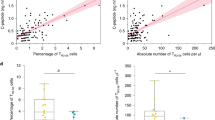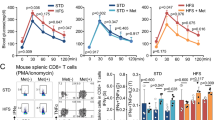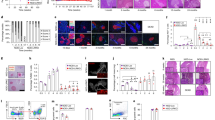Abstract
Complications arising from abnormal immune responses are the major causes of mortality and morbidity in diabetic patients. CD4+CD25+ T regulatory cells (Tregs) play pivotal roles in controlling immune homeostasis, immunity and tolerance. The effect of hyperglycemia on CD4+CD25+ Tregs has not yet been addressed. Here we used streptozotocin (STZ)-induced diabetic mice to study the effects of long-term hyperglycemia on CD4+CD25+ Tregs in vivo. Four months after the onset of diabetes, the frequency of CD4+CD25+Foxp3+ T regulatory cells was significantly elevated in the spleen, peripheral blood lymphocytes (PBLs), peripheral lymph nodes (pLNs) and mesenteric LNs (mLNs). CD4+CD25+ Tregs obtained from mice with diabetes displayed defective immunosuppressive functions and an activated/memory phenotype. Insulin administration rescued these changes in the CD4+CD25+ Tregs of diabetic mice. The percentage of thymic CD4+CD25+ naturally occurring Tregs (nTregs) and peripheral CD4+Helios+Foxp3+ nTregs were markedly enhanced in diabetic mice, indicating that thymic output contributed to the increased frequency of peripheral CD4+CD25+ Tregs in diabetic mice. In an in vitro assay in which Tregs were induced from CD4+CD25− T cells by transforming growth factor (TGF)-β, high glucose enhanced the efficiency of CD4+CD25+Foxp3+ inducible Tregs (iTregs) induction. In addition, CD4+CD25− T cells from diabetic mice were more susceptible to CD4+CD25+Foxp3+ iTreg differentiation than those cells from control mice. These data, together with the enhanced frequency of CD4+Helios−Foxp3+ iTregs in the periphery of mice with diabetes, indicate that enhanced CD4+CD25+Foxp3+ iTreg induction also contributes to a peripheral increase in CD4+CD25+ Tregs in diabetic mice. Our data show that hyperglycemia may alter the frequency of CD4+CD25+Foxp3+ Tregs in mice, which may result in late-state immune dysfunction in patients with diabetes.
This is a preview of subscription content, access via your institution
Access options
Subscribe to this journal
Receive 12 digital issues and online access to articles
$119.00 per year
only $9.92 per issue
Buy this article
- Purchase on Springer Link
- Instant access to full article PDF
Prices may be subject to local taxes which are calculated during checkout









Similar content being viewed by others
References
King GL . The role of inflammatory cytokines in diabetes and its complications. J Periodontol 2008; 79: 1527–1534.
Devaraj S, Cheung AT, Jialal I, Griffen SC, Nguyen D, Glaser N et al. Evidence of increased inflammation and microcirculatory abnormalities in patients with type 1 diabetes and their role in microvascular complications. Diabetes 2007; 56: 2790–2796.
Hotamisligil GS . Inflammation and metabolic disorders. Nature 2006; 444: 860–867.
Stentz FB, Umpierrez GE, Cuervo R, Kitabchi AE . Proinflammatory cytokines, markers of cardiovascular risks, oxidative stress, and lipid peroxidation in patients with hyperglycemic crises. Diabetes 2004; 53: 2079–2086.
Daoud AK, Tayyar MA, Fouda IM, Harfeil NA . Effects of diabetes mellitus vs. in vitro hyperglycemia on select immune cell functions. J Immunotoxicol 2009; 6: 36–41.
Stentz FB, Kitabchi AE . Activated T lymphocytes in type 2 diabetes: implications from in vitro studies. Curr Drug Targets 2003; 4: 493–503.
Ma H, Liu G, Ding W, Wu Y, Cai L, Zhao Y . Diabetes-induced alteration of F4/80+ macrophages: a study in mice with streptozotocin-induced diabetes for a long-term. J Mol Med 2008; 86: 391–400.
Bluestone JA, Abbas AK . Natural versus adaptive regulatory T cells. Nat Rev Immunol 2003; 3: 253–257.
Curotto de Lafaille MA, Lafaille JJ . Natural and adaptive foxp3+ regulatory T cells: more of the same or a division of labor? Immunity 2009; 30: 626–635.
Pop SM, Wong CP, Culton DA, Clarke SH, Tisch R . Single cell analysis shows decreasing FoxP3 and TGFbeta1 coexpressing CD4+CD25+ regulatory T cells during autoimmune diabetes. J Exp Med 2005; 201: 1333–1346.
Grinberg-Bleyer Y, Baeyens A, You S, Elhage R, Fourcade G, Gregoire S et al. Piaggio E IL-2 reverses established type 1 diabetes in NOD mice by a local effect on pancreatic regulatory T cells. J Exp Med 2010; 207: 1871–1878.
Tang Q, Adams JY, Penaranda C, Melli K, Piaggio E, Sgouroudis E et al. Central role of defective interleukin-2 production in the triggering of islet autoimmune destruction. Immunity 2008; 28: 687–697.
You S, Belghith M, Cobbold S, Alyanakian MA, Gouarin C, Barriot S et al. Autoimmune diabetes onset results from qualitative rather than quantitative age-dependent changes in pathogenic T-cells. Diabetes 2005; 54: 1415–1422.
Mellanby RJ, Thomas D, Phillips JM, Cooke A . Diabetes in non-obese diabetic mice is not associated with quantitative changes in CD4+CD25+Foxp3+ regulatory T cells. Immunology 2007; 121: 15–28.
Brusko T, Wasserfall C, McGrail K, Schatz R, Viener HL, Schatz D et al. No alterations in the frequency of FOXP3+ regulatory T-cells in type 1 diabetes. Diabetes 2007; 56: 604–612.
Brusko TM, Wasserfall CH, Clare-Salzler MJ, Schatz DA, Atkinson MA . Functional defects and the influence of age on the frequency of CD4+CD25+ T-cells in type 1 diabetes. Diabetes 2005; 54: 1407–1414.
Lindley S, Dayan CM, Bishop A, Roep BO, Peakman M, Tree TI . Defective suppressor function in CD4+CD25+ T-cells from patients with type 1 diabetes. Diabetes 2005; 54: 92–99.
Putnam AL, Vendrame F, Dotta F, Gottlieb PA . CD4+CD25high regulatory T cells in human autoimmune diabetes. J Autoimmun 2005; 24: 55–62.
Alizadeh BZ, Koeleman BP . Genetic polymorphisms in susceptibility to type 1 diabetes. Clin Chim Acta 2008; 387: 9–17.
Hu Y, Nakagawa Y, Purushotham KR, Humphreys-Beher MG . Functional changes in salivary glands of autoimmune disease-prone NOD mice. Am J Physiol 1992; 263: E607–E614.
Many MC, Maniratunga S, Denef JF . The non-obese diabetic (NOD) mouse: an animal model for autoimmune thyroiditis. Exp Clin Endocrinol Diabetes 1996; 104( Suppl 3): 17–20.
Salomon B, Rhee L, Bour-Jordan H, Hsin H, Montag A, Soliven B et al. Development of spontaneous autoimmune peripheral polyneuropathy in B7-2-deficient NOD mice. J Exp Med 2001; 194: 677–684.
D'Alise AM, Auyeung V, Feuerer M, Nishio J, Fontenot J, Benoist C et al. The defect in T-cell regulation in NOD mice is an effect on the T-cell effectors. Proc Natl Acad Sci USA 2008; 105: 19857–19862.
Thornton AM, Korty PE, Tran DQ, Wohlfert EA, Murray PE, Belkaid Y et al. Expression of Helios, an Ikaros transcription factor family member, differentiates thymic-derived from peripherally induced Foxp3+ T regulatory cells. J Immunol 2010; 184: 3433–3441.
Getnet D, Grosso JF, Goldberg MV, Harris TJ, Yen HR, Bruno TC et al. A role for the transcription factor Helios in human CD4+CD25+ regulatory T cells. Mol Immunol 2010; 47: 1595–1600.
Tabata T, Okuno Y, Fujii S, Kimura S, Kinoshita Y . Maturational impairment of thymic lymphocytes in streptozotocin-induced diabetes in rats. Cell Immunol 1984; 89: 250–258.
Mic AA, Mic FA, Tatu CA, Ionac M, Ordodi VL, Paunescu V . Indomethacin inhibits thymic involution in mice with streptozotocin-induced diabetes. Comp Med 2007; 57: 476–481.
Glisic S, Ehlenbach S, Jailwala P, Waukau J, Jana S, Ghosh S . Inducible regulatory T cells (iTregs) from recent-onset type 1 diabetes subjects show increased in vitro suppression and higher ITCH levels compared with controls. Cell Tissue Res 2010; 339: 585–595.
Chen W, Jin W, Hardegen N, Lei KJ, Li L, Marinos N et al. Conversion of peripheral CD4+CD25− naive T cells to CD4+CD25+ regulatory T cells by TGF-beta induction of transcription factor Foxp3. J Exp Med 2003; 198: 1875–1886
Fu S, Zhang N, Yopp AC, Chen D, Mao M, Chen D et al. TGF-beta induces Foxp3+ T-regulatory cells from CD4+CD25− precursors. Am J Transplant 2004; 4: 1614–1627.
Zheng SG, Wang J, Wang P, Gray JD, Horwitz DA . IL-2 is essential for TGF-beta to convert naive CD4+CD25− cells to CD25+Foxp3+ regulatory T cells and for expansion of these cells. J Immunol 2007; 178: 2018–2027.
Davidson TS, DiPaolo RJ, Andersson J, Shevach EM . Cutting edge: IL-2 is essential for TGF-beta-mediated induction of Foxp3+ T regulatory cells. J Immunol 2007; 178: 4022–4026.
Yamagiwa S, Gray JD, Hashimoto S, Horwitz DA . A role for TGF-beta in the generation and expansion of CD4+CD25+ regulatory T cells from human peripheral blood. J Immunol 2001; 166: 7282–7289.
Ryu JM, Lee MY, Yun SP, Han HJ . High glucose regulates cyclin D1/E of human mesenchymal stem cells through TGF-beta1 expression via Ca2+/PKC/MAPKs and PI3K/Akt/mTOR signal pathways. J Cell Physiol 2010; 224: 59–70.
Wang X, Shaw S, Amiri F, Eaton DC, Marrero MB . Inhibition of the Jak/STAT signaling pathway prevents the high glucose-induced increase in TGF-beta and fibronectin synthesis in mesangial cells. Diabetes 2002; 51: 3505–3509.
Ohshiro Y, Ma RC, Yasuda Y, Hiraoka-Yamamoto J, Clermont AC, Isshiki K et al. Reduction of diabetes-induced oxidative stress, fibrotic cytokine expression, and renal dysfunction in protein kinase Cbeta-null mice. Diabetes 2006; 55: 3112–3120.
Murawski MR, Litherland SA, Clare-Salzler MJ, Davoodi-Semiromi A . Upregulation of Foxp3 expression in mouse and human Treg is IL-2/STAT5 dependent: implications for the NOD STAT5B mutation in diabetes pathogenesis. Ann NY Acad Sci 2006; 1079: 198–204.
Burchill MA, Yang J, Vogtenhuber C, Blazar BR, Farrar MA . IL-2 receptor beta-dependent STAT5 activation is required for the development of Foxp3+ regulatory T cells. J Immunol 2007; 178: 280–290.
Long SA, Cerosaletti K, Bollyky PL, Tatum M, Shilling H, Zhang S et al. Defects in IL-2R signaling contribute to diminished maintenance of FOXP3 expression in CD4+CD25+ regulatory T-cells of type 1 diabetic subjects. Diabetes 2010; 59: 407–415.
You S, Slehoffer G, Barriot S, Bach JF, Chatenoud L . Unique role of CD4+CD62L+ regulatory T cells in the control of autoimmune diabetes in T cell receptor transgenic mice. Proc Natl Acad Sci USA 2004; 101( Suppl 2): 14580–14585.
Zhou X, Bailey-Bucktrout SL, Jeker LT, Penaranda C, Martinez-Llordella M, Ashby M et al. Instability of the transcription factor Foxp3 leads to the generation of pathogenic memory T cells in vivo. Nat Immunol 2009; 10: 1000–1007.
Shimizu J, Yamazaki S, Takahashi T, Ishida Y, Sakaguchi S . Stimulation of CD25+CD4+ regulatory T cells through GITR breaks immunological self-tolerance. Nat Immunol 2002; 3: 135–142.
Ronchetti S, Zollo O, Bruscoli S, Agostini M, Bianchini R, Nocentini G et al. GITR, a member of the TNF receptor superfamily, is costimulatory to mouse T lymphocyte subpopulations. Eur J Immunol 2004; 34: 613–622.
Ji HB, Liao G, Faubion WA, Abadia-Molina AC, Cozzo C, Laroux FS, Caton A et al. Cutting edge: the natural ligand for glucocorticoid-induced TNF receptor-related protein abrogates regulatory T cell suppression. J Immunol 2004; 172: 5823–5827.
You S, Poulton L, Cobbold S, Liu CP, Rosenzweig M, Ringler D et al. Key role of the GITR/GITRLigand pathway in the development of murine autoimmune diabetes: a potential therapeutic target PLoS One 2009; 4: e7848.
Acknowledgements
The authors wish to thank Ms Jing Wang and Mr Yabing Liu for their expert technical assistance, Ms Qinghuan Li for her excellent laboratory management, and Mr Baisheng Ren for his outstanding animal husbandry. This work was supported by grants from the National Basic Research Program of China (973 program, 2010CB945301), and National Natural Science Foundation for Key Programs (30630060). The authors declare no conflict of interest related to this manuscript.
Author information
Authors and Affiliations
Corresponding authors
Ethics declarations
Competing interests
The authors have declared no conflict of financial interest.
Supplementary information
Rights and permissions
About this article
Cite this article
Zhen, Y., Sun, L., Liu, H. et al. Alterations of peripheral CD4+CD25+Foxp3+ T regulatory cells in mice with STZ-induced diabetes. Cell Mol Immunol 9, 75–85 (2012). https://doi.org/10.1038/cmi.2011.37
Received:
Revised:
Accepted:
Published:
Issue Date:
DOI: https://doi.org/10.1038/cmi.2011.37
Keywords
This article is cited by
-
Diabetes mellitus exacerbates experimental autoimmune myasthenia gravis via modulating both adaptive and innate immunity
Journal of Neuroinflammation (2021)
-
Exendin-4 Exhibits Enhanced Anti-tumor Effects in Diabetic Mice
Scientific Reports (2017)
-
Hepatic immunophenotyping for streptozotocin-induced hyperglycemia in mice
Scientific Reports (2016)



